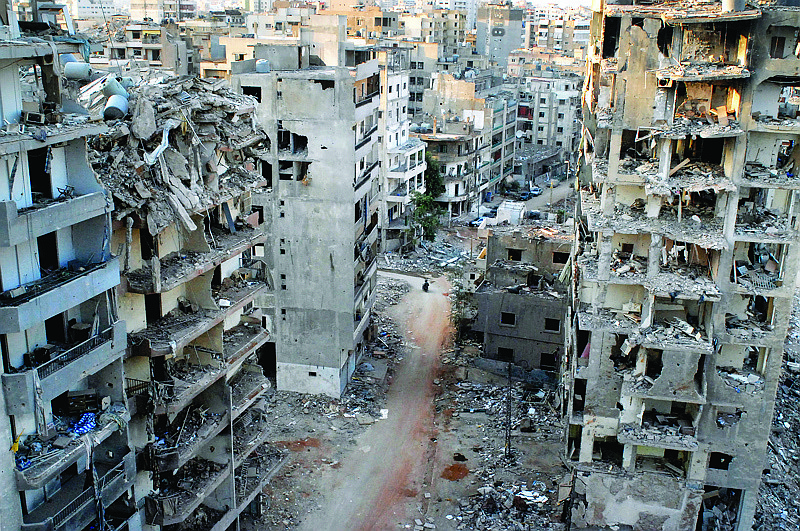- April 25, 2024
-
-
Loading

Loading

Everyone knows the saying.
“There’s two sides to every story.” Sometimes it’s used between a couple in an argument. Other times it’s used to defend someone accused of a crime. But at The Ringling’s latest photography exhibit, it describes the parallels between those who suffer the most in the wake of war.
“Aftermath: The Fallout of War — America and the Middle East” follows the perspectives of the people most affected by conflict in Iraq, Afghanistan, Syria, Lebanon, Libya, Palestine, and Israel. Refugees fleeing for a safer temporary home, civilians riding it out and living among rubble, American soldiers returning home with life-altering trauma — all are represented in this exhibit.
“We’re embroiled in the longest war our country has ever been in,” says guest curator Carol McCusker. “The human cost has always been with me. It’s a conversation and at the heart of it, it’s about empathy.”
McCusker, who works as the Harn Museum of Art’s curator of photography at University of Florida, says everyone is connected to this conflict. But she wants exhibit viewers to be mindful of those who are directly suffering as a result of it.
The idea for the exhibit came to McCusker in 2009, and it took about three years to put together with the organizational help of the Samuel P. Harn Museum of Art. One of the first artists she reached out to was Lynsey Addario, a freelance photojournalist whose conflict- and human rights-focused photos often appear on the cover of the New York Times.
McCusker formed an email relationship with Addario, whose photos McCusker acclaims for getting to the “heart of the issue.”
Another step in the process of picking pieces was working with an advisory committee that included wounded warriors from Afghanistan and Iraq.
“This was a vet’s personal aftermath,” she says while gesturing to a photo of American soldiers carrying their dead.
After gathering the collection of works now on display at the John and Mable Ringling Museum of Art, it was up to The Ringling’s Curator for Photography and New Media Chris Jones to bring it to life.
Jones says about a year before it opened in October, he began working with McCusker to determine how the museum space could best be utilized for the exhibit. The result is a sensory experience that allows visitors to not only see the people of this conflict but to hear their stories and the sounds of the setting in which they take place through video screens set up next to several pieces.
From the beginning he thought this exhibit had immense potential, Jones says, especially in terms of its timeliness.
“Topically, it’s incredibly relevant,” Jones says. “We’re unfortunately still engaged in the war on terror in the Middle East and in Afghanistan, and I think museums in the 21st century can be the perfect forum for people to actually engage with difficult issues.”
Jones says The Ringling is a space where everyone is welcome and visitors can take as much time as they choose to process the images they’re seeing, making it the perfect place to spark a conversation. He also notes that despite being a difficult topic, the photographers represented all approach the subject matter with great care and artistic value, adding the topic of creativity to the dialogue.
One example is the work of photographer Jennifer Karady and her narrative project, “Soldiers’ Stories from Iraq and Afghanistan.” In 2006, Karady started staging narrative photographs that depict the struggle of soldiers adjusting to civilian life upon their return from Afghanistan and Iraq. She also interviewed each of her subjects to create a first-person narrative to accompany each of her photos.
The result is a chilling look inside the mind of a soldier-turned-civilian, often suffering from post-traumatic stress disorder. From pulling over to inspect a tire mistaken for a bomb to reaching for a rifle that’s not there during every routine walk upstairs, these soldiers and their loved ones re-create the situations that are most triggering in their life.
Another photographer whose work is on display is Eman Mohammed, the first female photojournalist in Gaza. McCusker notes the exhibit is unique in that it features more female artists than male — nine female photographers and three male photographers have work on display.
This was both intentional and practical, she says, because women have more access to the domestic spaces in aftermath situations, making it easier for them to photograph.
“Their work can offer a perspective on conflict and its aftermath that’s different than their male counterparts,” Jones adds.
Jones considers the exhibit contemporary art photography, particularly because of the mixed media and video pieces mixed in with the traditional print photography on display. There are also several poems scattered throughout to help tell a full story.
Jones says people usually hear what’s going on in the Middle East through violent images and sound bites on the news, so he wants to give a new perspective.
“I think this is an opportunity to get a view of what’s been happening as part of a continuum, and to spend more time with individual images and individual instances.”